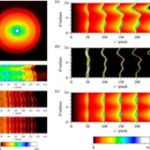 Image analysis software for processing of VMI images is available from our article in the Journal of Chemical Physics “Special Topic: Developments and Applications of Velocity Mapped Imaging Techniques”, Jason R. Gascooke, Stephen T. Gibson, and Warren D. Lawrance (2017). A “circularisation” method to repair deformations and determine the centre of velocity map images. Journal of Chemical Physics 147, 013924
Image analysis software for processing of VMI images is available from our article in the Journal of Chemical Physics “Special Topic: Developments and Applications of Velocity Mapped Imaging Techniques”, Jason R. Gascooke, Stephen T. Gibson, and Warren D. Lawrance (2017). A “circularisation” method to repair deformations and determine the centre of velocity map images. Journal of Chemical Physics 147, 013924
[10.1063/1.4981024]
Velocity Map Imaging (VMI) circularisation analysis method and software published
SALA exhibition
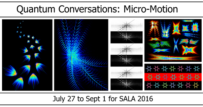 Quantum Conversation: Micro Motion exhibition for South Australian Living Artist (SALA). The microscopic motion of molecules is explored by using the quantum energy patterns they create from laser light, as seen in the Molecular Dynamics and Laser Spectroscopy Lab, Flinders University. This exhibition is inspired by the May 2016 issue of the science-art magazine, Interalia, titled “Micro-choreography“. Some of our work has been included as part of a “call to artists and scientists for images of their work that aesthetically represent the dynamics of microscopic & molecular processes”.
Quantum Conversation: Micro Motion exhibition for South Australian Living Artist (SALA). The microscopic motion of molecules is explored by using the quantum energy patterns they create from laser light, as seen in the Molecular Dynamics and Laser Spectroscopy Lab, Flinders University. This exhibition is inspired by the May 2016 issue of the science-art magazine, Interalia, titled “Micro-choreography“. Some of our work has been included as part of a “call to artists and scientists for images of their work that aesthetically represent the dynamics of microscopic & molecular processes”.
Carbon nanotube slicing features on Catalyst Science Show
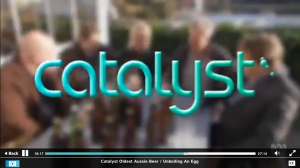 Slicing of carbon nanotubes using our lasers and the Vortex Fluidic Device features in the ‘Unboiling an Egg’ story on ABC’s Catalyst program broadcast June 14 2016. Uses for the device, including slicing carbon nanotubes to help make smaller solar cells, is discussed in the story which is also available on ABC iView from 18:15 minutes into the program.
Slicing of carbon nanotubes using our lasers and the Vortex Fluidic Device features in the ‘Unboiling an Egg’ story on ABC’s Catalyst program broadcast June 14 2016. Uses for the device, including slicing carbon nanotubes to help make smaller solar cells, is discussed in the story which is also available on ABC iView from 18:15 minutes into the program.
2DLIF artwork included in Interalia Magazine
Images from the lab have been included in the ‘Micro-Choreography’ issue of Interalia Magazine, May 2016. Our images are included in the ‘Micro-Choreography gallery‘ in response to an open call “to artists and scientists for images of their work that ‘aesthetically represent the dynamics of microscopic & molecular processes’”. From Interalia Magazine, “The aim of the issue is to highlight examples where aesthetic practice draws inspiration from the molecular sciences and ways in which science uses aesthetics to create representations of nature which are invisible to our eyes.”
Media interest growing
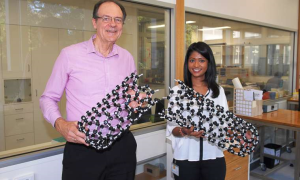 Articles about the slicing nanotubes research, recently published in Nature Scientific Reports, have appeared on several news websites:
Articles about the slicing nanotubes research, recently published in Nature Scientific Reports, have appeared on several news websites:
Nature Scientific Reports publishes carbon nanotube work
 We report on the use of a laser-based method to slice carbon nanotubes into small, constant-sized lengths. This is achieved by placing a solution of nanotubes in a vortex fluidic device (VFD) and irradiating with 1064nm infrared light from a Nd:YAG laser. The VFD is known to produce intense shear in liquids, and when coupled with laser irradiation at a specific power leads to cutting of the nanotubes.
We report on the use of a laser-based method to slice carbon nanotubes into small, constant-sized lengths. This is achieved by placing a solution of nanotubes in a vortex fluidic device (VFD) and irradiating with 1064nm infrared light from a Nd:YAG laser. The VFD is known to produce intense shear in liquids, and when coupled with laser irradiation at a specific power leads to cutting of the nanotubes.
- “Fluid dynamic lateral slicing of high tensile strength carbon nanotubes”, K. Vimalanathan, J.R. Gascooke, I. Suarez-Martinez, N.A. Marks, H Kumari, C.J. Garvey, J.L. Atwood, W.D. Lawrance and C.L. Raston, Scientific Reports, 6, 22865 (2016). doi:10.1038/srep22865 http://www.nature.com/articles/srep22865
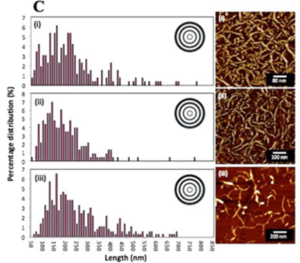
Dimer dissociation paper published
We investigated the dissociation of the van der Waals molecules of nitric oxide with rare gasses, in particular the complexes: NO-He, NO-Ne and NO-Ar.
- “Rotational and angular distributions of NO products from NO-Rg (Rg = He, Ne, Ar) complex photodissociation” H.L. Holmes-Ross, R.J. Valenti, H.-G. Yu, G.E. Hall and W.D. Lawrance, J. Chem. Phys. 144, 044309 (2016) doi:10.1063/1.4940690
RACI Physical Chemistry Symposium 2015
Daniel Wright gave a talk at the Royal Australian Chemical Institute’s (RACI) Physical Chemistry Symposium held at Flinders University City Campus, Victoria Square. Daniel’s talk discussed advances on characterising and calibration of his two-dimensional imaging Fourier transform infrared (FTIR) spectrometer.
The symposium is an annual meeting of physical chemistry researchers from Flinders University, University of South Australia, University of Adelaide and the DST Group. A poster session was held during the lunch break and Ula Alexander presented a poster on using our 2D-LIF as visual art and Jason Gascooke presented a poster on the uses of 2D-LIF for identifying molecular species and their motions.
Predicting torsion-rotation spectra of complex molecules
 Our work on understanding the energy flow in complex molecules has been published in Journal of Molecular Spectroscopy. We provide an efficient and reliable method for modelling microwave spectra that have been difficult to analyse and extract reliable physical information from, especially for complex molecules such as toluene which contains a rotating methyl group within its structure. The software developed to predict rotational energy changes in complex molecules such as toluene is available for use by other researchers working on rotational spectroscopy problems. Please contact Dr Jason Gascooke for more information.
Our work on understanding the energy flow in complex molecules has been published in Journal of Molecular Spectroscopy. We provide an efficient and reliable method for modelling microwave spectra that have been difficult to analyse and extract reliable physical information from, especially for complex molecules such as toluene which contains a rotating methyl group within its structure. The software developed to predict rotational energy changes in complex molecules such as toluene is available for use by other researchers working on rotational spectroscopy problems. Please contact Dr Jason Gascooke for more information.
- “The effects of torsion–vibration coupling on rotational spectra: Toluene reinterpreted and refitted”, J.R. Gascooke and W.D. Lawrance, J. Molec. Spectrosc. 318, 53 (2015). doi:10.1016/j.jms.2015.10.006 http://www.sciencedirect.com/science/article/pii/S0022285215300060
We have taken high-precision microwave absorption data for toluene from the literature and reanalysed it using a model that incorporates coupling between the methyl (CH3) torsion motion and the lowest energy vibration. From our previous analysis of 2D-LIF electronic spectra of toluene we find that we require such a coupling, however, the precise microwave data (due to changes in overall rotation of the molecule) was fit without it. We demonstrate that the microwave data can be fit equally as well by either including or excluding the coupling, and show why this is possible. Importantly, we find the barrier height to decrease substantially when the coupling is included, changing from 4.9 cm-1 to 1.8 cm-1 and the minimum energy conformation changes from the methyl hydrogens being staggered (relative to the phenyl plane) to eclipsed.
Science Alive 2015!
Art from the Laser Spectroscopy Lab will feature at Science Alive! 2015 as part of the Royal Australian Chemical Institute (SA Branch) exhibit to celebrate the International Year of Light. “Quantum Conversations- Art of Fluorescence” will be displayed for general public (~15,000 people expected to pass through the Science Alive exhibit in 2015).
Science Alive! 2015 is the largest science event in the southern hemisphere featuring exhibits from over 40 science organisations, including the Royal Australian Chemical Institute (RACI). The event aims to engage the general public with science through displays and hands-on activities.
